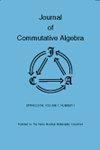ℎ——环
IF 0.6
4区 数学
Q4 MATHEMATICS
引用次数: 0
摘要
在20世纪60年代,Matlis将h局部域定义为一个(交换)积分域,其中每个非零元素只包含在有限多个极大理想中,每个非零素数理想包含在一个唯一的极大理想中。对于具有零因子的环,通过将“非零”变为“正则”,可以得到h - h局部环的定义。在文献中出现了近24种h - h局部域的等效表征。我们证明,如果用“正则局部化”代替“局部化”,并假设环是一个Marot环(即,每个正则理想都是由它的正则元素生成的),这些环中的大多数仍然等价于h - h -局部环。本文章由计算机程序翻译,如有差异,请以英文原文为准。
ℎ-local Rings
In the 1960’s, Matlis defined an h h -local domain to be a (commutative) integral domain in which each nonzero element is contained in only finitely many maximal ideals and each nonzero prime ideal is contained in a unique maximal ideal. For rings with zero-divisors, by changing “nonzero” to “regular,” one obtains the definition of an h h -local ring. Nearly two dozen equivalent characterizations of h h -local domain have appeared in the literature. We show that most of these remain equivalent to h h -local ring if one also replaces “localization” by “regular localization” and assumes that the ring is a Marot ring (i.e., every regular ideal is generated by its regular elements).
求助全文
通过发布文献求助,成功后即可免费获取论文全文。
去求助
来源期刊

Journal of Commutative Algebra
MATHEMATICS-
CiteScore
0.80
自引率
16.70%
发文量
28
审稿时长
>12 weeks
期刊介绍:
Journal of Commutative Algebra publishes significant results in the area of commutative algebra and closely related fields including algebraic number theory, algebraic geometry, representation theory, semigroups and monoids.
The journal also publishes substantial expository/survey papers as well as conference proceedings. Any person interested in editing such a proceeding should contact one of the managing editors.
 求助内容:
求助内容: 应助结果提醒方式:
应助结果提醒方式:


